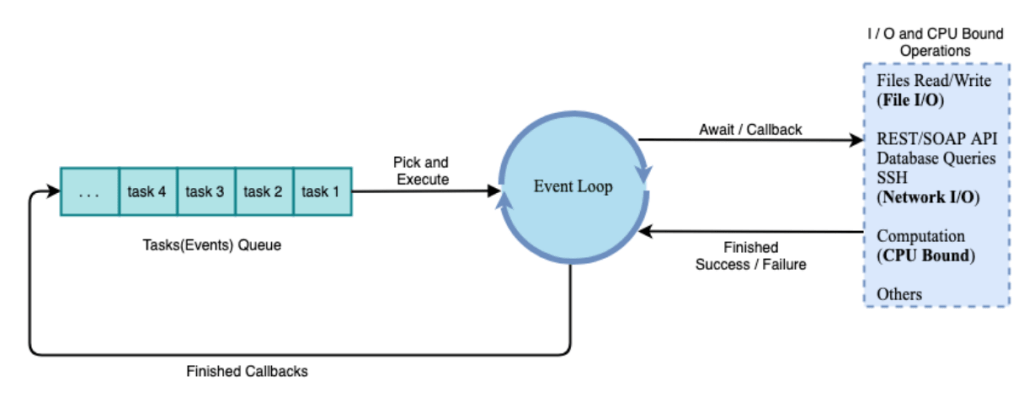Concurrency in Python: Threading, Processes, and Asyncio
Introduction
Concurrency is a critical concept in modern programming, as it enables programs to perform multiple tasks simultaneously, resulting in faster and more efficient code. By breaking down a program into smaller, independent tasks that can execute concurrently, developers can make the most efficient use of system resources, such as CPU, memory, and I/O. This is in contrast to sequential processing, where each task is executed one after the other, resulting in slower performance and decreased efficiency. With the increasing demand for applications to handle large volumes of data and perform complex operations in real-time, concurrency has become an essential skill for developers. By leveraging the power of concurrency, developers can write code that is more efficient and scalable, capable of handling multiple tasks simultaneously. In today’s fast-paced technological world, it is becoming increasingly critical to harness the power of concurrency to deliver high-performing applications.
Techniques for Achieving Concurrency in Python
Python provides several techniques for achieving concurrency, each with its strengths and weaknesses. The most popular techniques are threading, process-based concurrency, and asynchronous I/O. Threading is a technique that involves creating multiple threads within a single process, allowing tasks to run concurrently within the same process. Process-based concurrency involves running multiple processes in parallel, allowing tasks to run concurrently across multiple processes. Asynchronous I/O is a technique that allows tasks to run concurrently without creating multiple threads or processes. Instead, it uses a single event loop that coordinates the execution of multiple tasks. Each of these techniques has its benefits and drawbacks, and the choice of technique will depend on the specific needs of the application. In the next sections, we will discuss each of these techniques in more detail and provide insights into their benefits and limitations.
Threading
Threading is a technique for achieving concurrency in Python that involves creating multiple threads within a single process. Each thread runs independently, allowing tasks to run concurrently within the same process. Threading is particularly useful when the tasks to be executed require a lot of CPU time, as it allows them to run concurrently, maximizing the utilization of system resources. However, threading in Python has some limitations. One major limitation is the Global Interpreter Lock (GIL), which limits the ability of threads to run concurrently when executing Python code. The GIL can make it difficult to achieve true parallelism in Python applications, which can impact the performance of CPU-bound tasks. Nevertheless, threading is still a useful technique for achieving concurrency in Python, particularly for I/O-bound tasks.

Example
import threading
def worker():
print(f"Thread {threading.current_thread().name} is running")
threads = []
for i in range(5):
t = threading.Thread(target=worker)
t.start()
threads.append(t)
for t in threads:
t.join()
print("All threads have completed")Output
Thread Thread-1 (worker) is running
Thread Thread-2 (worker) is running
Thread Thread-3 (worker) is running
Thread Thread-4 (worker) is running
Thread Thread-5 (worker) is running
All threads have completedPros and Cons of Threading
Pros:
- Threading allows tasks to run concurrently within the same process, maximizing the utilization of system resources.
- It is particularly useful for I/O-bound tasks that can benefit from overlapping I/O operations with CPU-bound tasks.
- Threading can improve the responsiveness of applications by allowing tasks to run in the background while the main thread handles user input and output.
- It is relatively easy to implement and does not require significant changes to the existing codebase.
Cons:
- Threading in Python is limited by the Global Interpreter Lock (GIL), which can make it difficult to achieve true parallelism when executing Python code.
- The GIL can impact the performance of CPU-bound tasks, as threads may not be able to run concurrently when executing Python code.
- Thread-based concurrency can lead to synchronization issues, such as race conditions and deadlocks, which can be difficult to debug and fix.
- Debugging threaded code can be challenging, as the behavior of threads can be unpredictable and hard to reproduce.
Processes
Process-based concurrency is a technique for achieving concurrency in Python that involves running multiple processes in parallel. Each process runs independently, with its memory space, allowing tasks to run truly concurrently across multiple processes. Process-based concurrency is particularly useful for CPU-bound tasks, as it allows them to run truly concurrently, maximizing the utilization of system resources. Process-based concurrency is not limited by the Global Interpreter Lock (GIL), allowing Python applications to achieve true parallelism. However, since each process has its memory space, interprocess communication (IPC) can be more challenging to implement.

Example
import multiprocessing
def worker():
print(f"Process {multiprocessing.current_process().name} is running")
processes = []
for i in range(5):
p = multiprocessing.Process(target=worker)
p.start()
processes.append(p)
for p in processes:
p.join()
print("All processes have completed")
Output
Process Process-1 is running
Process Process-2 is running
Process Process-3 is running
Process Process-4 is running
Process Process-5 is running
All processes have completed
Pros and Cons of Processes
Pros:
- Process-based concurrency allows tasks to run truly concurrently across multiple processes, maximizing the utilization of system resources.
- It is particularly useful for CPU-bound tasks, as it allows them to run truly concurrently, without being limited by the GIL.
- Debugging process-based concurrency is generally easier than debugging threaded code, as each process has its memory space and runs independently.
- IPC mechanisms can be used to facilitate communication between processes and share data between them.
Cons:
- Creating and managing multiple processes can impose significant overhead on the system, which can impact the performance of the application.
- IPC mechanisms can be more challenging to implement and can introduce additional overhead and complexity.
- Processes are generally more heavyweight than threads, requiring more system resources to create and manage.
Asyncio
Asyncio is a library in Python that provides infrastructure for writing asynchronous I/O-bound code. It allows for the concurrent execution of coroutines, which are functions that can be paused and resumed during execution. Asyncio can be seen as a combination of the benefits of threading and processes, allowing for the efficient handling of I/O-bound tasks while still being able to execute CPU-bound tasks concurrently. It is particularly useful for network programming, as it can handle many network connections simultaneously without the need for threads or processes.

Example
import asyncio
async def worker():
print("Starting worker")
await asyncio.sleep(1)
print("Worker finished")
async def main():
tasks = []
for i in range(5):
tasks.append(asyncio.create_task(worker()))
await asyncio.gather(*tasks)
asyncio.run(main())
Output
Starting worker
Starting worker
Starting worker
Starting worker
Starting worker
Worker finished
Worker finished
Worker finished
Worker finished
Worker finished
Pros and Cons of Asyncio
Pros:
- Asyncio allows for the efficient handling of I/O-bound tasks by allowing multiple coroutines to execute concurrently.
- It can handle many network connections simultaneously, making it well-suited for network programming.
- Asyncio is not limited by the Global Interpreter Lock (GIL), allowing for true parallelism when executing Python code.
- Debugging asynchronous code can be easier than debugging threaded or process-based code, as coroutines are lighter weight and easier to reason about than threads or processes.
Cons:
- Asyncio requires the use of the asyncio library and a specific programming style, which can take time to learn and adapt to.
- It is not well-suited for CPU-bound tasks, as it may not be able to achieve true parallelism when executing Python code.
- Debugging can still be challenging in complex applications, as the interactions between coroutines can be difficult to reason about.
Comparing the Techniques
Each of the concurrency techniques in Python has its own set of advantages and disadvantages. Threading is a good choice for I/O-bound tasks that require parallelism but do not require much CPU usage. It can be simpler to implement and is well-suited for tasks such as network programming. Processes are a better choice for CPU-bound tasks or tasks that require isolation from other processes. Processes are also more fault-tolerant than threads, as a single misbehaving process will not affect other processes. Asyncio is well-suited for I/O-bound tasks and network programming, and it can handle many network connections simultaneously without the need for threads or processes. However, it may not be the best choice for CPU-bound tasks, as it may not achieve true parallelism. Ultimately, the choice of concurrency technique will depend on the specific requirements of the project.
Choosing the Right Technique for Your Project
Choosing the right concurrency technique for a project can be a difficult decision. It requires a thorough understanding of the project requirements and the strengths and weaknesses of each technique. When making this decision, consider the following factors:
- The type of task: Is the task I/O-bound or CPU-bound? Does it require parallelism or isolation from other processes?
- The complexity of the code: How easy is it to implement each technique in the codebase? Is the codebase already designed to work with a specific technique?
- The resources available: How much memory and processing power is available? How many network connections need to be handled simultaneously?
- The expected load: How much traffic is expected? How many tasks will be running concurrently?
By considering these factors, it is possible to make an informed decision about which concurrency technique to use for a specific project.
Conclusion
Concurrency is an important aspect of programming in Python and is necessary for building responsive and efficient applications. In this blog post, we have explored the various concurrency techniques available in Python, including threading, processes, and asyncio. Each of these techniques has its own set of pros and cons and is better suited for different types of tasks. When choosing a concurrency technique, it is important to consider the specific requirements of the project and to choose the technique that best meets those requirements.
By understanding the different concurrency techniques available in Python and their respective strengths and weaknesses, developers can make informed decisions about which technique to use for a particular project. Ultimately, the choice of concurrency technique will depend on the specific requirements of the project, the available resources, and the expected load.
Add Comment
You must be logged in to post a comment.







